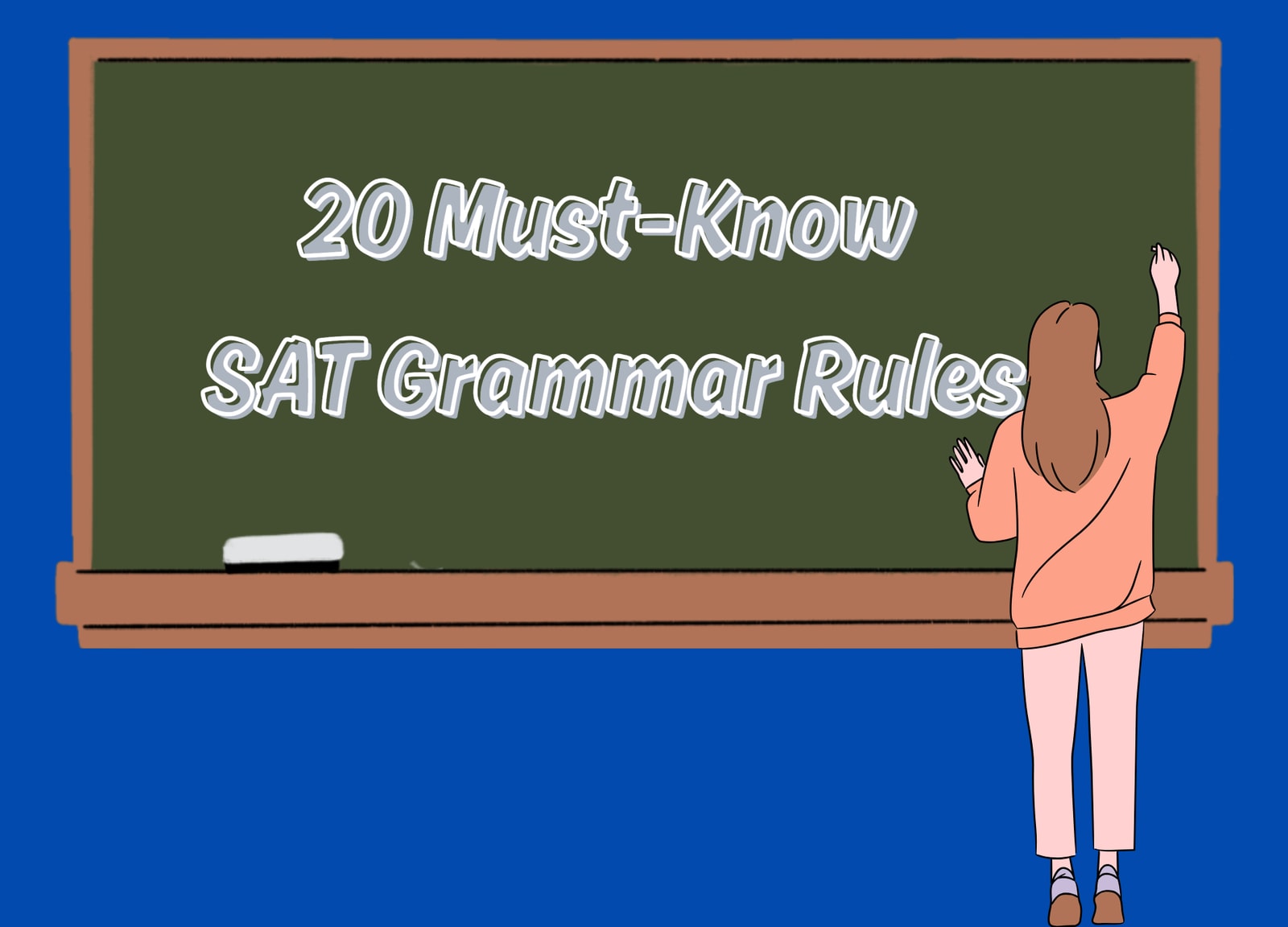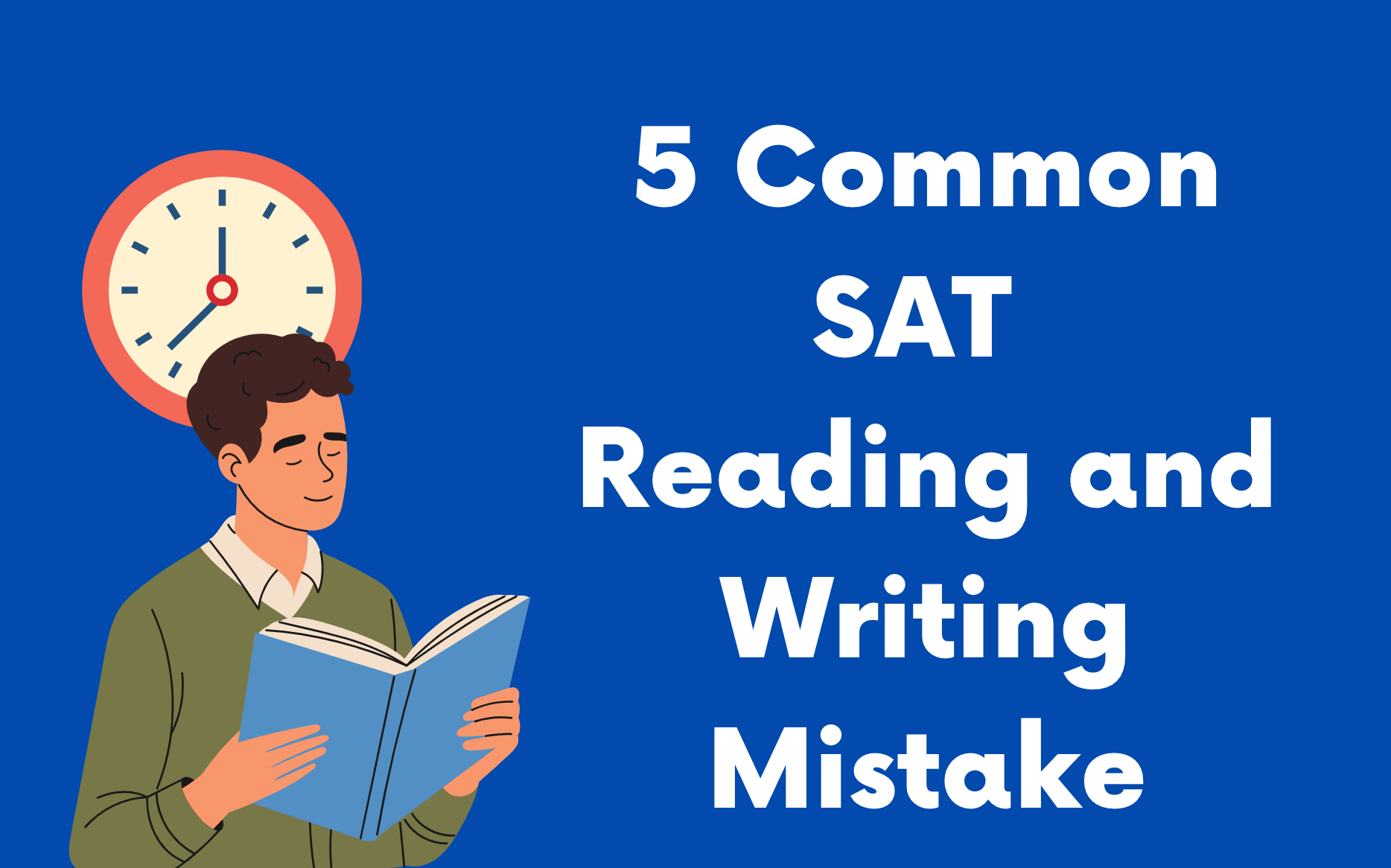20 Must-Know SAT Grammar Rules
Author
Phoenix Wilder
Date Published

If you're preparing to take the SAT this year, chances are you've started exploring the vast world of SAT preparation. Your initial steps might include determining what qualifies as a "good" SAT score and experimenting with tools like the SAT Score Calculator to set your goals. Remember, what counts as a "good" SAT score depends on your personal ambitions and the schools you're targeting. Reviewing the SAT score ranges of admitted students at various institutions can give you clarity in defining your target. Once you’ve mapped out your SAT goals, it’s time to prepare for the different sections of the test. In this guide, we’ll focus on 20 key grammar rules you’ll need for SAT success.
Where Will You Apply Grammar on the SAT?
As a refresher, the digital SAT consists of two timed sections, each containing two equally timed modules:
- Reading and Writing (64 minutes total, divided into two 32-minute modules)
- Math (70 minutes total, divided into two 35-minute modules)
Our focus here is the Reading and Writing section, which assesses your understanding of grammar, writing style, and language conventions. Questions are categorized into two primary types:
1. Questions that call for improving the expression of ideas
2. Questions requiring you to identify and correct errors in sentence structure, grammar, word usage, and punctuation
The second type—related to "Standard English Conventions"—tests your ability to spot and fix mechanical, grammar, and usage problems. Familiarity with common grammatical rules is essential to performing well on these questions and the Reading and Writing section overall.
Why Should You Learn SAT Grammar Rules?
Building fluency in SAT grammar rules not only boosts your test performance but also strengthens your general reading comprehension and writing skills. These improvements help you in other academic settings, like AP tests, writing-heavy coursework, and even in everyday communication.
20 SAT Grammar Rules Cheatsheet
We’ll break these rules into two broad categories: 1) Syntax and Mechanics and 2)Punctuation.
Part One: Syntax and Mechanics
1. Subjects and Verbs Must Agree
Subjects must align in number with their corresponding verbs. Singular subjects take singular verbs, while plural subjects take plural verbs.
- Incorrect: The dog chase the ball.
- Correct: The dog chases the ball.
Pro Tip: In present tense, third-person singular verbs usually end with "s."
2. Transitive vs. Intransitive Verbs
Transitive verbs must have a direct object, while intransitive verbs don’t require one. A transitive verb’s meaning feels incomplete unless it "transfers" action to something.
- Incorrect: Scruffy carries.
- Correct: Scruffy carries her toy.
3. Collective Nouns Are Singular
Collective nouns such as "group," "committee," or "crowd" refer to multiple entities but function as singular subjects.
- Incorrect: The crowd demand bread.
- Correct: The crowd demands bread.
Pro Tip: Words like "crowds" or "groups" (plural forms) take plural verbs instead.
4. Pronouns Must Have Clear Antecedents and Match in Number
A pronoun’s reference must be unambiguous and must agree in number with the noun it represents.
Incorrect: Katie and Scruffy were playing when she got thirsty.
Correct: Katie and Scruffy were playing when Scruffy got thirsty.
5. Correlative Conjunctions Come in Pairs
Correlative conjunctions are pairs of conjunctions that work together to link two words, phrases, or clauses, emphasizing their relationship as equal parts in a sentence. These pairs ensure parallelism and correct sentence structure.
Here are some of the most frequently used correlative conjunctions:
Either/or
Neither/nor
Such/that
Whether/or
Not only/but also
Both/and
As many/as
Rather/than
No sooner/than
Examples of Proper Usage:
1. Scruffy would rather go to the park than the vet.
Here, "rather" is correctly paired with "than."
2. Katie loves the music of both Taylor Swift and Beyoncé.
"Both" and "and" link two equal elements, ensuring the sentence's balance.
Pro Tip: When dealing with correlative conjunctions, locate the first conjunction in the pair (e.g., either, neither, both), ensure its corresponding partner (e.g., or, nor, and) is present and properly placed, and check that the two connected parts share parallel grammatical form.
6. Prepositional Phrases Don’t Determine Subject Plurality
A prepositional phrase modifies other parts of the sentence without affecting the subject’s singular/plural status.
- Incorrect: The herd of cattle graze in the meadow.
- Correct: The herd of cattle grazes in the meadow.
Pro Tip: Cross out prepositional phrases to clearly identify the sentence’s subject.
7. Modifiers Should Stay Close to the Word They Modify
Modifiers are words, phrases, or clauses that clarify or describe another word, phrase, or clause. Misplaced or dangling modifiers lead to sentences that are ambiguous or awkward. Hence, whenever a modifier appears, it must be next to the word, phrase, or clause it is modifying.
- Incorrect: They adopted a puppy for my sister they call Scruffy.
- Correct: They adopted a puppy they call Scruffy for my sister.
As you can see, in the incorrect sentence it seems that the sister is called Scruffy. While not impossible, the context of the sentence indicates that the word being modified by “they call Scruffy” is “puppy,” not “sister.”
Pro Tip: Often, correcting a misplaced or dangling modifier requires restructuring the sentence and adding words and/or punctuation.
8. Maintain Consistent Verb Tenses
Ensure verbs within the same sentence or passage remain consistent in tense unless there is a shift in time.
- Incorrect: Scruffy loves her toys and carried them everywhere.
- Correct: Scruffy loves her toys and carries them everywhere.
Pro Tip: To avoid tense issues, use the surrounding sentences as context clues by checking if the narrative is in past, present, or future tense and aligning verbs within the same sentence or closely connected sentences to the established tense.
9. Parallel Structure Matters
Sentence elements that are similar in meaning must have parallel grammar.
- Incorrect: Scruffy enjoys running, lounging, and to play fetch.
- Correct: Scruffy enjoys running, lounging, and playing fetch.
In the incorrect version, “going” and “lounging” are gerunds (verbs acting as nouns), while “to play” is an infinitive. To maintain parallelism, “to play” should be changed to “playing” to match the gerund pattern.
Pro Tip: Parallelism issues can also arise when noun numbers are inconsistent, parts of speech don’t align, or the ideas expressed in a sentence are unrelated.
10. Avoid Run-On Sentences
To identify run-on sentences, it’s important to first understand compound sentences. A compound sentence contains two or more independent clauses, meaning there are at least two subjects and two verbs. If these independent clauses aren’t joined properly, the result is a run-on sentence.
- Incorrect: The puppy will learn to sit eventually you need to keep taking her to puppy class.
This sentence contains two independent clauses:
1. The puppy will learn to sit eventually.
2. You need to keep taking her to puppy class.
However, these clauses are not connected correctly.
Run-on sentences can be fixed using the following methods:
1. Add a comma and coordinating conjunction (for, and, nor, but, or, yet, so):
- Correct: The puppy will learn to sit eventually, but you need to keep taking her to puppy class.
2. Divide the sentence into two separate sentences:
- Correct: The puppy will learn to sit eventually. You need to keep taking her to puppy class.
3. Use a semicolon:
- Correct: The puppy will learn to sit eventually; you need to keep taking her to puppy class.
Pro Tip: Don’t assume that run-ons are always excessively long. Even short sentences can be classified as run-ons if independent clauses aren’t joined properly.
11. Fix Sentence Fragments
A sentence fragment is an incomplete thought that lacks either a subject or a predicate (the verb and what follows it). Fragments often result because part of the sentence is missing crucial information.
- Incorrect: Scruffy sleeping peacefully on the couch.
- Correct: Scruffy is sleeping peacefully on the couch.
Pro Tip: We often associate sentence fragments with being short (just as we associate run-on sentences with being long), but this isn’t always true.
12. Memorize Homophones
Homophones are words that sound alike (or almost alike) but have different meanings. They often trip students up because of their similar pronunciations. While there’s no quick trick for mastering homophones, practicing their usage can help.
Common SAT-relevant homophones include:
Your/you’re
There/their/they’re
Whose/who’s
Its/it’s
To/too/two
Here/hear
Affect/effect
Weather/whether
Passed/past
Loose/lose
- Incorrect: Katie through the ball for Scruffy.
- Correct: Katie threw the ball for Scruffy.
Pro Tip: On the SAT, homophones will often appear in the context of longer passages. Even though simpler homophones like "its/it’s" or "your/you’re" are common errors, they can be harder to spot under time pressure—so practice carefully!
13. Who vs. Whom, Who's vs. Whose, That vs. Which
Mastering a few specific grammatical distinctions can help you avoid some of the most common SAT traps.
Who vs. Whom
- Who: Functions as the subject of a sentence.
Example: Who owns this toy?
- Whom: Functions as the object of a verb or preposition.
Example: To whom should I give this squeaky toy?
Who’s vs. Whose
- Who’s: Contraction for "who is" or "who has."
Example: Who’s the dog’s owner? (= Who is the dog’s owner?)
- Whose: Shows possession.
Example: Whose toy is this?
That vs. Which
- That: Introduces a restrictive clause—essential to the meaning of the sentence.
Example: The sandwich that has the homemade pickles is my favorite!
- Which: Introduces a non-restrictive clause, providing additional (but non-essential) information.
Example: This sandwich, which has homemade pickles, is delicious!
Pro Tip: Pinpoint which of these distinctions gives you trouble and spend extra time committing their rules to memory.
Part Two: Punctuation
14. Semicolons and Colons
Understanding proper comma usage requires distinguishing between restrictive and non-restrictive clauses:
-Restrictive Clauses
Restrictive clauses are essential to the sentence's meaning. Removing a restrictive clause would significantly alter the message of the sentence.
Example: Puppies who attend classes learn basic commands.
If you removed "who attend classes," the meaning of the sentence would be incomplete, as it would refer to all puppies instead of a specific group.
Restrictive clauses should not be surrounded by commas.
- Non-Restrictive Clauses
Non-restrictive clauses add extra information that is not essential to the sentence's main idea.
Example: Scruffy, who is very cute, learned basic commands during puppy classes.
If "who is very cute" is removed, the general meaning of the sentence remains the same.
Non-restrictive clauses must be surrounded by commas.
- Appositives
Appositives are descriptive phrases that do not contain verbs and provide additional detail. These, like non-restrictive clauses, should be set off by commas.
Example: Scruffy, a golden retriever puppy, learned basic commands during puppy classes.
Pro Tip: If information in a clause can be removed without affecting the sentence’s essential meaning, use commas to surround it.
15. Commas Shouldn’t Join Two Sentences
Using a comma to separate two independent clauses creates what's called a comma splice, a common grammar mistake.
- Incorrect: My sister loves Taylor Swift, she dances to her music all the time.
- Correct: My sister loves Taylor Swift, and she dances to her music all the time.
- Correct: My sister loves Taylor Swift; she dances to her music all the time.
- Correct: My sister loves Taylor Swift. She dances to her music all the time.
Pro Tip: A quick test for comma splices is to replace the comma with a period. If both resulting sentences are complete and make sense, then a comma isn’t sufficient, and another correction is needed.
16. Semicolons Can Separate Two Independent Clauses
Unlike commas, semicolons are grammatically correct for separating independent clauses. Use semicolons where the relationship between ideas is close but a full stop (period) feels too final.
- Incorrect: Since my sister loves Taylor Swift; she drove four hours to attend her concert.
- Correct: My sister loves Taylor Swift; she drove four hours to attend her concert.
Pro Tip: If you replace the semicolon with a period and create two independent, complete sentences, the semicolon is being used correctly.
17. Colons Can Only Come After an Independent Clause
Colons are used to introduce lists, examples, or explanations but should always follow a complete sentence.
- Incorrect: Scruffy enjoys many activities like: going to the park, riding in the car, chewing her squeaky toys, and playing with Katie.
- Correct: Scruffy enjoys many activities: going to the park, riding in the car, chewing her squeaky toys, and playing with Katie.
Pro Tip: Replace the colon with a period. If the first half of the sentence is still complete and makes sense, then the colon is properly placed.
18. Use Em Dashes to Separate Nonessential Elements
An em dash (—) separates nonessential parts of a sentence from the essential content. Em dashes can replace parentheses, commas, or even colons in some cases, depending on style or emphasis.
Example: Scruffy’s favorite ball—because of its green color—was difficult to spot in the grass.
You can also use a single em dash at the end of a sentence to emphasize a nonessential detail:
Example: Scruffy is afraid of two things—cats and thunder.
Pro Tip: While the choice to use an em dash is largely stylistic, remember it must set apart nonessential elements.
19. Use Apostrophes Correctly to Form Possessives or Contractions
Using apostrophes properly is crucial for writing clear and grammatically correct sentences.
- If a word is singular, add ’s to show possession:
Example: Scruffy’s favorite ball is green.
- If a word is plural and does not end in "s," add ’s:
Example: The children’s play area is large.
- If a word is plural and does end in "s," add only an apostrophe:
Example: The puppies’ owners were kind.
- Use apostrophes to replace dropped letters in contractions:
Examples: it’s (it is), don’t (do not), could’ve (could have).
Pro Tip: Apostrophes are NOT used to form plural nouns (e.g., Tuesdays, not Tuesday’s unless possessive).
20. Punctuation Marks (Almost Always) Go Inside Quotation Marks
When using quotation marks, place certain punctuation inside the quotation marks:
Periods and commas almost always go inside:
Example: "Scruffy loves her ball," said Katie.
Pro Tip: Question marks and exclamation points go inside if they are part of the quoted material but outside if they apply to the whole sentence.
Final Tips for Mastery
These 20 grammar rules may appear simple in theory, but they are crucial when tackling SAT Reading and Writing questions. Keep practicing, reviewing errors, and building confidence—you’re well on your way to success! Tools like Best SAT Score's full length practice tests and expert-curated question bank can further refine your skills and help you achieve your target score.
Related Posts

Struggling with the Digital SAT Reading & Writing section? Discover 5 common mistakes students make and actionable tips to boost your score!

Master the SAT Reading section with essential strategies for big picture questions, enhancing your comprehension and boosting your score.